 For
a full overview click
here
For
a full overview click
here London Thames sundial trail
If you would like a guided walk to view some of the London sundials please contact Judy Stephenson or Tim Kidd
 For
a full overview click
here For
a full overview click
here London Thames sundial trail |
|||
|---|---|---|---|
| CONDUCTED SUNDIAL TOURS IN LONDON If you would like a guided walk to view some of the London sundials please contact Judy Stephenson or Tim Kidd |
|||
The tour starts in Parliament Square (tube station: Westminster). Parliament
Square has Big Ben near its north-east corner, and the Houses of Parliament
(including the very ancient Westminster Hall) along the east side. On
the south side is the great bulk of Westminster Abbey, and in front of
it, the small church of St. Margaret's Westminster. 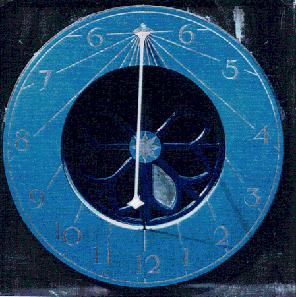 St Margaret's has four sundials , designed by C. St.J. Daniel, on its
tower, and is a very good illustration of how the appearance of a vertical
sundial depends on the direction in which the wall is facing. . The sundial
on the south face has the gnomon (which casts the shadow) slanting out
from sundial at the angle of the co-latitude (so that the gnomon points
at the Celestial Pole, and is thus parallel with the axis of the earth),
and the hour lines fanning out from the base of the gnomon. You can see
that the hour lines are symmetrical about the vertical 12 o'clock line.
This shows that this sundial is pointing due south.
St Margaret's has four sundials , designed by C. St.J. Daniel, on its
tower, and is a very good illustration of how the appearance of a vertical
sundial depends on the direction in which the wall is facing. . The sundial
on the south face has the gnomon (which casts the shadow) slanting out
from sundial at the angle of the co-latitude (so that the gnomon points
at the Celestial Pole, and is thus parallel with the axis of the earth),
and the hour lines fanning out from the base of the gnomon. You can see
that the hour lines are symmetrical about the vertical 12 o'clock line.
This shows that this sundial is pointing due south. The gnomons on the east and west faces also have to point directly at the Celestial Pole, and thus be parallel to the gnomon on the south-facing dial. The only way this can be done is by having the gnomon standing out from the surface of the dial. The hour lines are parallel lines marked on the dialplate. The east-facing dial records the morning hours, up to solar noon, and the west-facing dial records the afternoon hours. There is also a north-facing dial. Its gnomon points in the same direction as the others, towards the Celestial Pole, which means that it projects upwards from the dialplate. This dial records only the hours between 6 pm and 6 am, so that it is only operational in the summer months. There is a new analemmatic ("human gnomon") sundial in Palace Yard. From the porch of St Margaret's, turn eft alongside Westminster Abbey on your right, and turn right when you reach Millbank. The sundial is set in the middle of the paved yard some 40 metres down the street This sundial was placed here in 2002 to mark Queen Elizabeth's Golden Jubilee. The yard is paved in granite to remind you that it is part of the Palace of Westminster. You stand on the line closest to the date, and your shadow falls on the time indicated in the circle of hours. The motto comes from Shakespeare's King Henry V and reads " ōTo carve out dials quaintly, point by point, thereby to see the minutes how they run: how many makes the hour full complete, how many hours brings about the day, how many days will finish up the year, how many years a mortal man may live.ö
Walk back to Parliament Square, turn right towards Westminster Bridge and turn left along Victoria Embankment. Walk along a very pleasant 200m pathway to Embankment Gardens at the back of the Savoy Hotel. You will pass six splendid memorials including those to the Imperial Camel Corps, Robert Burns, Rakes (Sunday schools) and Sullivan. In the gardens you will see the SAVOY HOTEL EQUATORIAL DIAL This superb modern stainless steel Equatorial Armillary Dial was designed and made by Christopher St Daniel and Brockbrae. 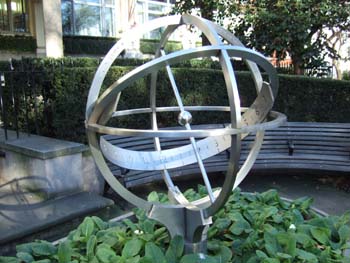 It is set in a rounded rectangular flower container. On one side of this
is the following inscription: “This garden was given to London by
the Savoy Hotel in celebration of its centenary” On the other sides
are inscriptions commemorating various illustrious people connected with
both the Savoy Hotel and the D’Oyley Carte company from 1889-1989.
The Coat of Arms of the Savoy Hotel is also inscribed. On the metal work
is engraved the wording “Savoy Centenary 1989- For Excellence we
Strive, and Every Season has its cheer - Life is lovely all the year.”
It is set in a rounded rectangular flower container. On one side of this
is the following inscription: “This garden was given to London by
the Savoy Hotel in celebration of its centenary” On the other sides
are inscriptions commemorating various illustrious people connected with
both the Savoy Hotel and the D’Oyley Carte company from 1889-1989.
The Coat of Arms of the Savoy Hotel is also inscribed. On the metal work
is engraved the wording “Savoy Centenary 1989- For Excellence we
Strive, and Every Season has its cheer - Life is lovely all the year.”
Turn left onto Victoria Embankment, and bear left into Temple Place. Left again and walk up Arundel Street to St Clement Danes Church facing you on island in the Strand. ST CLEMENT DANES CHURCH ,STRAND 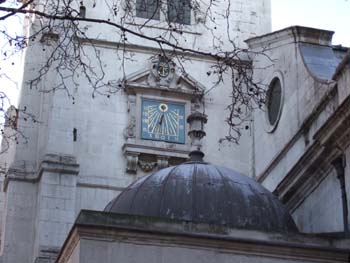 Predating
the Norman Conquest (1066), and rebuilt by Christopher Wren after the
Great Fire, this church was damaged again during the Blitz of World War
2, when the walls and the elegant tower by James Gibbs survived. Predating
the Norman Conquest (1066), and rebuilt by Christopher Wren after the
Great Fire, this church was damaged again during the Blitz of World War
2, when the walls and the elegant tower by James Gibbs survived. High up on the south face of the tower there is a large 1 metre, vertical declining sundial which has been recently restored. This church is famous for its peal of bells, and the nursery rhyme “ Oranges and Lemons, Say the bells of St Clements”. This attribution has been disputed. The clock of St Clements was designed to strike the hours twice, once on the big bell and once on the small bell. Just in case this was not enough there were originally sundials on the south and the west faces of the tower. The story goes that a payment of £1 15s 0d was made to Mr Wyn, Mathematician, for “designing two sunndyals on the Church wall”. Return to the south side of the Strand, walk east to the second turning and turn right into Essex Street. Turn left at the Edgar Wallace pub into Devereux Court and through the big gates into the Middle Temple and New Court. Turn right towards the fountain ahead and left into FOUNTAIN COURT. ESSEX COURT DIAL ( is in fact in Fountain Court ) 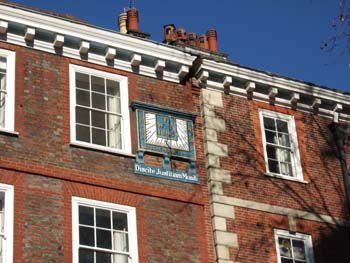 Since this vertical declining dial was placed on the wall of Brick Court
opposite the Middle Temple Hall in 1685, the plane trees have grown so
tall as to almost obscure the sun. It is made of stone, beautifully maintained
and has the motto 'Discite Justitium Moniti' or 'Learn justice you who
are now being instructed'.
Since this vertical declining dial was placed on the wall of Brick Court
opposite the Middle Temple Hall in 1685, the plane trees have grown so
tall as to almost obscure the sun. It is made of stone, beautifully maintained
and has the motto 'Discite Justitium Moniti' or 'Learn justice you who
are now being instructed'. Return to the fountain and walk South down the flight of steps into Garden Court, towards Middle Temple Gardens. If these are closed you will still get a restricted view of a horizontal dial in the distance. Middle Temple Gardens are open to the public on weekdays 12-3 in May, June July September. MIDDLE TEMPLE GARDENS DIAL 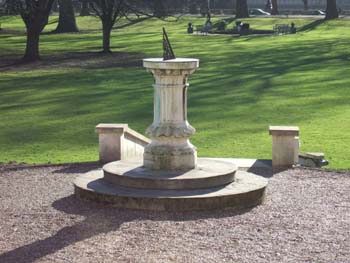 This is a horizontal dial around 1830 in excellent condition around 380
mm diameter.
This is a horizontal dial around 1830 in excellent condition around 380
mm diameter. Return to Fountain Court and turn left up Middle Temple Lane. Turn right into arch signed towards Pump Court. MIDDLE TEMPLE, PUMP COURT 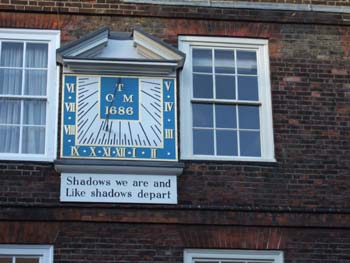 This is a sister dial to the Essex Court Dial; another stone vertical
declining dial (South 10 East) dated 1686, with the morbid motto -“Shadows
we are and like Shadows we depart”.
This is a sister dial to the Essex Court Dial; another stone vertical
declining dial (South 10 East) dated 1686, with the morbid motto -“Shadows
we are and like Shadows we depart”. Walk across Pump Court through 3 Arches into a square with Temple Church on the left, and continue through an arch into Kings Bench Walk. Turn right down Kings Bench Walk and right again, past Paper Buildings to the gardens on the left hand [south] side in Crown Office Row. Gardens open to the public 12.30 - 15.00 Mon-Fri. Public not admitted unless accompanied by a member of the Inner Temple. Maybe you will be as lucky as we were. We went into the Treasury Office sign posted in Crown Office row and asked permission to go into the gardens to see the sundials. Permission was readily given. CROWN OFFICE WALK HORIZONTAL DIAL 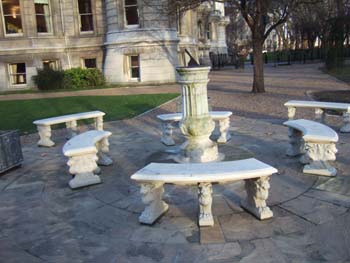 This horizontal sundial is made of metal on a stone plinth, and is in
very good condition. It has an ornate gnomon, with Pegasus and the initials
TRP on it. It is dated on the gnomon 1707.
This horizontal sundial is made of metal on a stone plinth, and is in
very good condition. It has an ornate gnomon, with Pegasus and the initials
TRP on it. It is dated on the gnomon 1707. 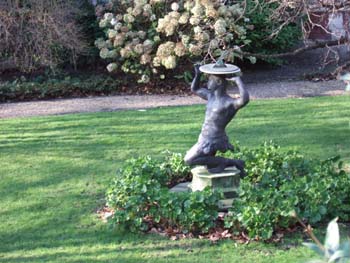
INNER TEMPLE Kings Bench Walk You can see this dial clearly through the railings, although there is no general public access to these gardens. It is worth a look for its odd plinth. A crouching statue of a black boy holds a horizontal dial on his head. The gnomon is dated 1886, and the maker is Newton & Co 3 Fleet Street. The date on the gnomon base is 1731. The dial and the statue are not of the same date and have been assembled at some time unknown. Two similar statues exist in Manchester and Cheshire and are believed to be part of a set of five. Return to the Embankment, and cross it to the river side. Turn left along the river, taking the pedestrian underpass beneath Blackfriars Bridge, and continue for another 300 yards till you are nearly at the Millennium Footbridge Click here for a streetmap of this section of this trail 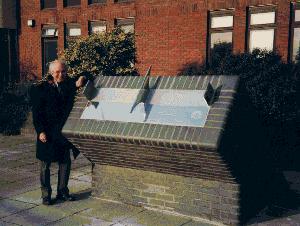 Outside the City of London Boys School is a polar sundial designed by
Piers Nicholson, and mounted on a plinth of exactly 2000 blue engineering
bricks. The sundial was built by the Royal Engineers and presented to
the Corporation of London by the Worshipful Company of Tylers and Bricklayers
in December 1999. The badges of the three organisations are engraved with
an inscription on the stainless steel gnomon, which has a matt dialplate
marked in Roman numerals for winter time and in Arabic numerals for summer
time. There is more information about this sundial here
Outside the City of London Boys School is a polar sundial designed by
Piers Nicholson, and mounted on a plinth of exactly 2000 blue engineering
bricks. The sundial was built by the Royal Engineers and presented to
the Corporation of London by the Worshipful Company of Tylers and Bricklayers
in December 1999. The badges of the three organisations are engraved with
an inscription on the stainless steel gnomon, which has a matt dialplate
marked in Roman numerals for winter time and in Arabic numerals for summer
time. There is more information about this sundial here
Map 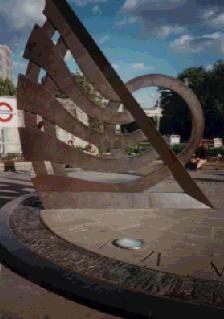 The next sundial is outside Tower Hill tube station, and you can get there
by tube from Blackfriars. If it is a fine day, (and after it is re-opened
sometime in 2002) you could walk over the Millennium footbridge, past
the new Tate Modern art gallery, and continue along the south bank riverside
walk, making diversions if you like to see the Globe Theatre or Southwark
Cathedral.. Ignore Southwark and London Bridges, and cross back to the
north bank at Tower Bridge. As you cross the river, the Tower of London
will be on your left, and behind it, further away from the river, is Tower
Hill station. This has a large horizontal sundial in a small courtyard
outside the Tube station.
The next sundial is outside Tower Hill tube station, and you can get there
by tube from Blackfriars. If it is a fine day, (and after it is re-opened
sometime in 2002) you could walk over the Millennium footbridge, past
the new Tate Modern art gallery, and continue along the south bank riverside
walk, making diversions if you like to see the Globe Theatre or Southwark
Cathedral.. Ignore Southwark and London Bridges, and cross back to the
north bank at Tower Bridge. As you cross the river, the Tower of London
will be on your left, and behind it, further away from the river, is Tower
Hill station. This has a large horizontal sundial in a small courtyard
outside the Tube station. The Tower Hill Dial is also part of the City of London sundial trail, another trail worth following and you might like to join it here. 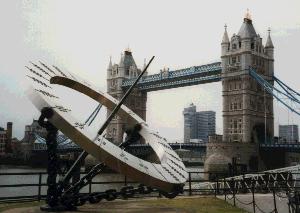 To reach the last sundial on the tour at St Katherine's Dock, make for
the approach road to Tower Bridge, and find the small service road on
the downstream side which leads down to the St. Katherine's Hotel. On
the far side of the hotel on the riverbank is a large equatorial dial.
To reach the last sundial on the tour at St Katherine's Dock, make for
the approach road to Tower Bridge, and find the small service road on
the downstream side which leads down to the St. Katherine's Hotel. On
the far side of the hotel on the riverbank is a large equatorial dial.
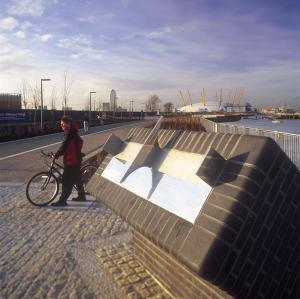 If
you are visiting the Dome, you can see another of the Tylers and Bricklayers
Sundials near the Millennium Village on the east side of the Greenwich
peninsula. Map If
you are visiting the Dome, you can see another of the Tylers and Bricklayers
Sundials near the Millennium Village on the east side of the Greenwich
peninsula. Map
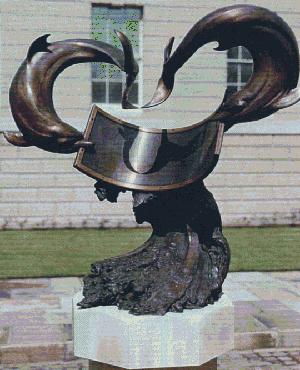
If you have more time, it is worth making a trip to Greenwich, which can be reached either by river or on the Jubilee Line. The river trip is far better scenically, but takes quite a bit longer. Greenwich has the new Millennium Dome as well as the superb National Maritime Museum and Queen's House. The Cutty Sark, one of the most famous of the tea clippers, is also moored here. There is another of polar sundials, similar to the Blackfriars one described above, near the Millennium Village on the Greenwich Peninsula. And, outside the tearoom of the National Maritime Museum, is (in our opinion) the best modern sundial in England, the superb dolphin sundial designed by C St J Daniel. If you have enjoyed following this trail, you would also enjoy the City of London sundial trail which will take you to many interest corners of the City, the heart of London |